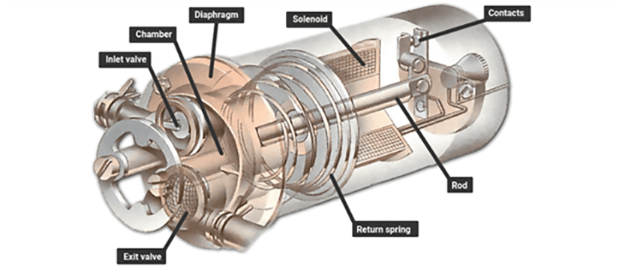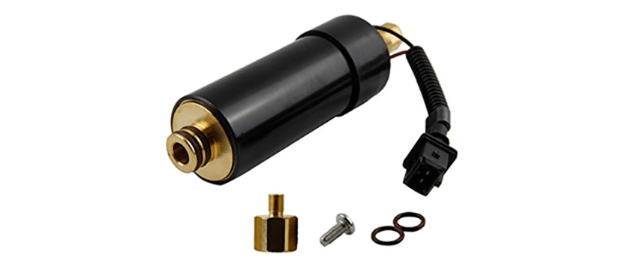Buying a fuel pump for your car can sometimes be a daunting and confusing task. At maxpeedingrods.com, it is our mission to make that task as easy and painless as possible. This Buyer's Guide is designed to answer any questions you may have during your search for the right fuel pump for your car, and it also includes instructions on how to buy a fuel pump from the MaXpeedingRods website.
What is a fuel pump?
The fuel pump in your vehicle has the task of getting fuel from your fuel tank or reservoir into your
engine. In most modern vehicles, the fuel pump will generally be part of a full fuel pump assembly which
will include the sending unit, level arm and fuel filter.
The types of fuel pumps include:
Mechanical fuel pumps are found in vehicles with engines using a carburetor as means to deliver fuel into the engine. These are usually older vehicles. Newer cars will not have this style of fuel pump. Mechanical fuel pumps are located inside the engine bay.
• Electric Fuel PumpAn electric fuel pumps is the most common type of fuel pump you will find in vehicles driving on today's roads. In most cases you will find the electric fuel pump submerged right inside the fuel tank working together with the fuel injectors in your car. In comparison to the mechanical fuel pump, the electric fuel pump typically pumps gas at a higher pressure (usually around 30-40 psi, compared to the 2-6 psi commonly found on older mechanical fuel pumps).
• Direct injection fuel pumpAnother style of fuel pump that can be found on direct injection vehicles is a direct injection fuel pump. Direct injection fuel pumps incorporate elements of mechanical fuel pumps and work in conjunction with an in-tank electric fuel pump. A direct injection fuel pump is most often located inside the engine bay and is mechanically driven by the camshaft, the oil pump or a vacuum pump. An in-tank electric fuel pump sends fuel from the tank to the direct injection fuel pump, at a typical fuel pressure of 35-40 psi. The direct injection fuel pump then increases the pressure to around 2000 – 3000 psi and sprays it directly into the combustion chamber.

HOW A FUEL PUMP WORKS?
The fuel pump in a vehicle pushes fuel from the tank to the engine. The unit usually sits in the tank of the vehicle using an electric powered motor and consists of an array of valves and springs that work in conjunction to create suction. This suction draws fuel into the pump which causes the return spring to push the fuel up into the lines creating pressure.
The fuel pressure in the lines is not regulated by the pump itself, the pump will just pump to its maximum ability with the voltage provided from the vehicle. The fuel pressure is regulated down the fuel lines at the motor by a fuel pressure regulator also known as an FPR. The higher the voltage applied to the pump, the faster the pump will move, and the higher the flow of fuel will be from the pump. Generally, a fuel pump will be part of an assembly which will also include a sending unit, level arm, and screen filter.
HOW TO CHOOSE A FUEL PUMP?
Fuel pumps come in different shapes and sizes and with varying features. Selecting a fuel pump is simple for an unmodified stock vehicle. Simply choose the pump based on your vehicle VIN, the pump OEM number or your vehicle make, model, and year. When searching for a fuel pump for a modified or custom fuel delivery setup for performance engines, one must ensure that they choose the right fit for their engine. Different factors affect the selection of a fuel pump. However, the most important determining factors include the engine's fuel efficiency, horsepower, voltage, and the maximum fuel system pressure.
Engine Fuel EfficiencyThe efficiency of an engine is the amount of fuel required to produce 1 HP for 60 minutes. It is also known as the engine's Brake Specific Fuel Consumption (or simply BSFC). Modern engines fall into three broad categories based on their BSFC rating.
• Engine Type: Normal Aspirated Engine
• Industry B.S.F.C Standards: .45 – .5
• Engine Type: Supercharged engines (nitrous combinations)
• Industry B.S.F.C Standards: .55 – .60
• Engine Type: Turbocharged engines (forced induction)
• Industry B.S.F.C Standards: .6 – .65
These figures are just general guidelines. Owners can determine the exact BSFC of their engine by
conducting
an engine dyno test.
A car's fuel volume is reliant on its horsepower rating and BSFC. Owners can calculate the average fuel requirement by multiplying these two values. For instance, for a 650 HP engine with a .45 BSFC, the amount of fuel required equals 660 multiplied by .45, which is 292 lbs of fuel. The more efficient the engine, the higher the BSFC and the amount of fuel required. When shopping for an electric fuel pump, it is best to play it safe, and get a pump that can deliver slightly more fuel than the engine actually needs. Drivers who are unsure of their car's horsepower should consult with an experienced mechanic. Basing calculations on the wrong HP estimates can lead to serious engine damage.
VoltageModern electric fuel pump systems rely on electricity. Fuel injectors are designed to work within certain voltage limits. When choosing a fuel pump, drivers must select pumps that fit with the voltage output of the engine. For instance, attaching a fuel pump designed to work with 12 volts to another vehicle that outputs 13.5 volts, increases the volume of fuel being pumped by as much as 40 percent. This can quickly lead to pump issues. Excessive voltage can also affect the fuel pump relay.
DIAGNOSING A FAULTY FUEL PUMP
The biggest indication of a faulty fuel pump is an irregular supply of fuel to the engine. When a fuel pump is bad, the vehicle may begin to lose power, jerk while in motion, or simply not start. If a fuel pump develops an irreparable problem, drivers can opt to either replace the faulty unit on their own or take it to a skilled mechanic.
Because fuel is highly flammable, it is important that drivers only perform the replacement on their own if they are confident of their ability. It also helps if drivers work with a pump replacement guide to figure out key issues like where the fuel pump is located.
If for any reason you cannot find your fuel pump by searching your vehicle's year, make and model, the best way to find the right fuel pump for your car is by searching by the Original Equipment Manufacturer (OEM) part number of your stock fuel pump assembly. The OEM part number can be found directly on the part itself.

WHY BUY FUEL PUMPS FROM MAXPEEDINGRODS?
•All MaXpeedingRods fuel pumps meet or exceed OEM standards and ensure a perfect fit into your
vehicle.
•All MaXpeedingRods fuel pumps are made from the highest quality components to ensure adequate and
constant fuel pressure in all conditions and all engine loads for many many miles.
•All Maxpeedingrods fuel pumps are tested to ensure sufficient flow and correct operation and come with
a warranty against manufacturer defects.
•MaXpeedingRods offers a seamless online shopping experience and the streamlined e-commerce interface
makes it easy for you to find the fuel pump you want.
•MaXpeedingRods offers a variety of high-quality fuel pumps for many different makes, models, and
applications.
•MaXpeedingRods has been engaged in the research, development, test, and manufacturing of automotive and
racing products for decades and creates products that offer an ideal blend of quality and price.
WHAT ARE THE SYMPTOMS OF A BAD OR FAILING FUEL PUMP?
Because the fuel pump is the component responsible for supplying the engine with the fuel required for it to run, any issues with it can cause major drivability and performance problems. Usually, a bad or failing fuel pump will produce one or more of the following 8 symptoms that alert the driver of a potential issue.
1. Whining Noise From the Fuel TankOne of the first symptoms of a problem with the fuel pump is a loud whining sound. An old or worn fuel pump may produce a noticeably loud whine or howl while running. Most fuel pumps will produce a quiet hum during their normal operation, however, an excessively loud whine coming from the fuel tank is usually a sign of a problem. There may not be enough fuel, a damaged pump, or contaminated fuel inside the system.
2. Difficulty StartingAnother symptom commonly associated with a problematic fuel pump is difficulty starting. Because fuel pumps constantly run whenever the ignition is turned on, they can eventually wear out and weaken over time. A weak fuel pump may still pump fuel, but the vehicle may experience difficulty starting from the lack of pressure. A weakened fuel pump can cause the vehicle to take more cranks to start than normal, and in more serious cases may even cause the vehicle to require multiple turns of the key before it will start.
3. Engine SputteringOne of the surest indicators of a faulty fuel pump is a sputtering engine — typically at high speeds. Should you be driving at a consistently high speed and the engine suddenly sputter before returning to normal operation, it may indicate issues within the fuel pump. In this case, the fuel pump cannot provide a constant stream of fuel to the engine at the ideal pressure.
4. Stalling at High TemperaturesStalling can happen because of multiple problems within a vehicle but pay attention when it happens frequently at high temperatures shown on the car's thermometer. A rising temperature paired with stalling often indicates a problem with the fuel pump motor. If stalling continues to occur together with a rising temperature gauge, it could indicate the fuel pump's deterioration and need for replacement.
5. Loss of Power Under StressAnother indication of a bad fuel pump is a loss of power when the vehicle is under load — such as driving uphill or carrying a heavy load — or while accelerating. The engine shuts down because weakening parts of the fuel pump cannot keep up with the car's heightened fuel demands in these situations. In these circumstances, the car will feel like it is unable to go or maintain the intended amount of power. If the fuel pump is the cause, it means it can no longer regulate fuel pressure accurately and provide the appropriate amount of fuel to the engine.
6. Car SurgingIrregular resistance inside the fuel pump motor may cause vehicle surging, and indicates a fuel pump in need of repair. Surging feels like the gas pedal has been used and results in increased rpm for brief periods of time, it can occur at random but it's easiest to spot when the vehicle is coming to a stop or when idling. If this happens often, it may be because of problems within the fuel pump.
7. Low Gas MileageIf it seems like you're filling up your car more than usual, it may be because of an issue within the fuel pump. A valve within the fuel pump may not be opening, causing more fuel than necessary to pour into the engine system. Excess fuel in the engine causes the engine to run rich which negatively impacts gas mileage and power. In extreme cases too much fuel can dilute the engine oil and cause engine damage.
8. Car Will Not StartAnother more serious symptom of an issue with the fuel pump is a no-start condition. If the fuel pump fails completely — to the point of not being able to provide enough fuel for the engine to run, the vehicle will refuse to start. The engine will still crank when the key is turned, but it will be unable to start due to the lack of fuel. A no-start situation can also be caused by a variety of other issues, such as no spark, so having the vehicle properly diagnosed is highly recommended.
How to install a fuel pump in a car?
IFirst and foremost, remember that you're dealing with gasoline—a highly flammable, dangerous substance. Don't smoke while working on the fuel system and keep all sources of sparks or flame far away from the vehicle and fuel tank during the entire procedure. Keep in mind that light bulbs can be very hot, so keep your incandescent shop light on the bench, and use LEDs if you need to work at night.
Also remember that static electricity from your clothes, the vehicle's interior, or other sources can create a spark, and that spark could be deadly. When removing fuel from the tank, be sure to use a hand siphon pump. Don't use an electric pump—there's a risk of a spark causing an explosion.
Step 1: Disconnect the negative battery cable.
Step 2: With a safe workspace laid out, and your car parked on a level, firm surface, jack it up and place it on jack stands, or use a lift to provide access to the underside of the car.
Step 3: Relieve the fuel system pressure. (How to do this varies between makes and models, so refer to the service manual for your specific vehicle.)
Step 4: Disconnect the filler neck from the fuel tank per your service manual.
Step 5: Support the fuel tank with the jack and a block of wood.
Step 6: Remove the bolts from the straps holding the fuel tank in the vehicle.
Step 7: Carefully disconnect the wiring connections, fuel lines, and vent hoses on the top of the tank before fully lowering the tank.
Step 8: Once the connections are released, use the jack to carefully lower the tank out of the car.
Step 9: Clean the top of the tank around the existing fuel pump assembly to prevent any dirt or debris from falling into the tank during removal.
Step 10: Refer to your service manual for instructions on removing the fuel pump assembly from the tank. There's typically a plate held in place with screws or bolts, which, once released, enables removal of the pump.
Step 11: Install the new pump in the opposite order you used to remove the old one.
Step 12: Reconnect the fuel lines, wiring connections, and vent tubes, and reinstall the fuel tank.
Step 13: Reconnect the fuel filler tube.
Step 14: Reconnect the negative battery cable.
Step 15: Fill the tank with gas and go for a drive to verify that you've properly replaced the fuel pump and that everything is in proper working order.







